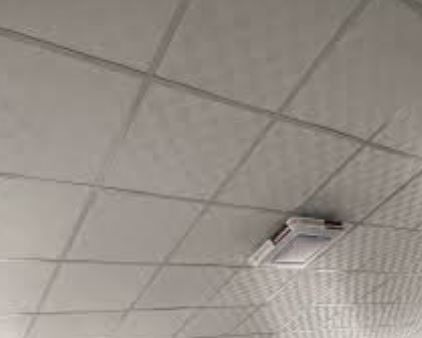
Introduction to Smart Grid Ceilings
Smart grid ceilings represent a cutting-edge technology that integrates energy management and building control systems within ceiling structures. They offer multiple benefits.
What Are Smart Grid Ceilings?
Smart grid ceilings are advanced ceiling systems that incorporate sensors, lighting, and energy management technologies. They enhance building efficiency and control. Smart grid ceilings integrate advanced technology to optimize energy use, enhance comfort, and provide real-time control for improved building management.
Components of Smart Grid Ceilings
Integrated Sensors
Sensors within smart grid ceilings monitor various environmental factors such as temperature, humidity, and occupancy levels. They provide real-time data.
LED Lighting
LED lights integrated into the ceiling grid can be adjusted for brightness and color temperature. They contribute to energy efficiency and comfort.
Climate Control Systems
These systems manage heating, ventilation, and air conditioning (HVAC) directly from the ceiling. They ensure optimal indoor climate control.
Data Connectivity
Smart grid ceilings are connected to a central data network, allowing for real-time monitoring and management of building systems.
Benefits of Smart Grid Ceilings
Energy Efficiency
Smart grid ceilings enhance energy efficiency by optimizing lighting and climate control based on real-time data and occupancy. This reduces overall energy consumption.
Cost Savings
By improving energy efficiency and reducing operational costs, smart grid ceilings can lead to significant cost savings over time. They provide a good return on investment.
Enhanced Comfort
These systems create a more comfortable environment by adjusting lighting and climate controls to suit individual preferences and needs.
Improved Building Management
Smart grid ceilings offer centralized control and monitoring capabilities, improving overall building management and operational efficiency.
Installation of Smart Grid Ceilings
Professional Installation vs. DIY
Professional installation is recommended for smart grid ceilings due to the complexity of integrating various systems and technologies. DIY installation is challenging.
Steps for Professional Installation
Planning and Design
Develop a comprehensive plan and design for the smart grid ceiling system, considering the building’s specific requirements and layout.
System Integration
Integrate sensors, lighting, and climate control systems into the ceiling grid. Ensure proper connections to the central data network.
Testing and Calibration
Test the entire system to ensure all components are functioning correctly. Calibrate sensors and controls for optimal performance.
DIY Installation Tips
Research and Preparation
Thoroughly research the installation process and requirements before starting. Proper preparation is crucial for successful DIY installation.
Follow Manufacturer Instructions
Adhere strictly to the manufacturer’s instructions for installing and configuring smart grid ceiling components. This ensures proper functionality.
Regular Monitoring
After installation, regularly monitor the system to ensure it operates as intended. Address any issues promptly to maintain performance.
Maintenance and Care
Routine Inspections
Perform regular inspections of smart grid ceilings to check for any signs of wear or malfunction. Regular maintenance is crucial for long-term performance.
Cleaning Guidelines
Keep the ceiling grid and integrated components clean to ensure optimal performance. Use appropriate cleaning methods and avoid damaging sensitive parts.
Upgrading Systems
Technology advancements may necessitate upgrading components or software. Stay informed about new developments to enhance system capabilities and efficiency.
Comparing Smart Grid Ceilings to Traditional Ceilings
Cost Comparison
Smart grid ceilings may have a higher initial cost compared to traditional ceiling systems. However, they offer long-term savings and efficiency benefits.
Energy Efficiency
Smart grid ceilings generally provide superior energy efficiency compared to traditional ceilings. They optimize lighting and climate control based on real-time data.
Control and Management
Traditional ceilings lack the integrated control and monitoring capabilities of smart grid systems. Smart grid ceilings offer advanced management features.
Applications of Smart Grid Ceilings
Residential Use
In homes, smart grid ceilings provide enhanced comfort, energy efficiency, and control. They contribute to a more modern and adaptable living environment.
Commercial Use
Smart grid ceilings are ideal for commercial buildings, including offices, retail spaces, and hotels. They improve energy management and building operations.
Industrial Use
In industrial settings, smart grid ceilings help manage large spaces and complex systems. They enhance operational efficiency and worker comfort.
Future Trends in Smart Grid Ceiling Technology
Advancements in Sensors
Future smart grid ceilings may feature advanced sensors with improved accuracy and additional functionalities. This will enhance system performance and data collection.
Integration with IoT
The integration of smart grid ceilings with Internet of Things (IoT) technology will enable even greater control and automation of building systems.
Sustainability Focus
As sustainability becomes more critical, smart grid ceilings will incorporate eco-friendly materials and energy sources, further improving environmental impact.
Case Studies and Examples
Residential Installation in Urban Areas
A recent residential project in an urban area utilized smart grid ceilings to enhance energy efficiency and comfort. The results were impressive.
Commercial Office Building Upgrade
An office building upgrade included smart grid ceilings to improve energy management and occupant satisfaction. The project demonstrated substantial operational savings.
Industrial Facility Improvement
In an industrial facility, smart grid ceilings were installed to better control environmental conditions and reduce energy consumption. The benefits were significant.
Cost Analysis and Budgeting
Initial Investment
The initial investment for smart grid ceilings includes costs for materials, installation, and system integration. It is generally higher than traditional ceilings.
Long-Term Savings
Over time, smart grid ceilings can lead to considerable savings in energy and operational costs. The return on investment can be significant.
Financing Options
Explore financing options if the upfront cost of smart grid ceilings is a concern. Many suppliers and financial institutions offer flexible plans.
Conclusion
Smart grid ceilings represent an innovative approach to building management, offering energy efficiency, cost savings, and enhanced comfort. They integrate advanced technology and control systems into ceiling structures.
Adopting smart grid ceilings can transform how buildings are managed and operated, leading to improved efficiency and satisfaction. As technology continues to advance, smart grid ceilings will become increasingly valuable in various applications.